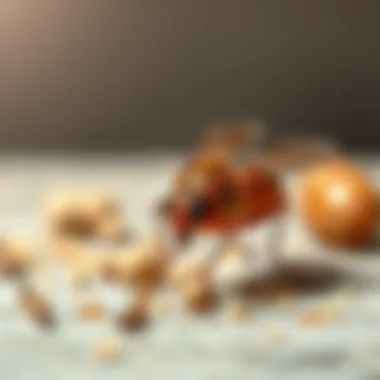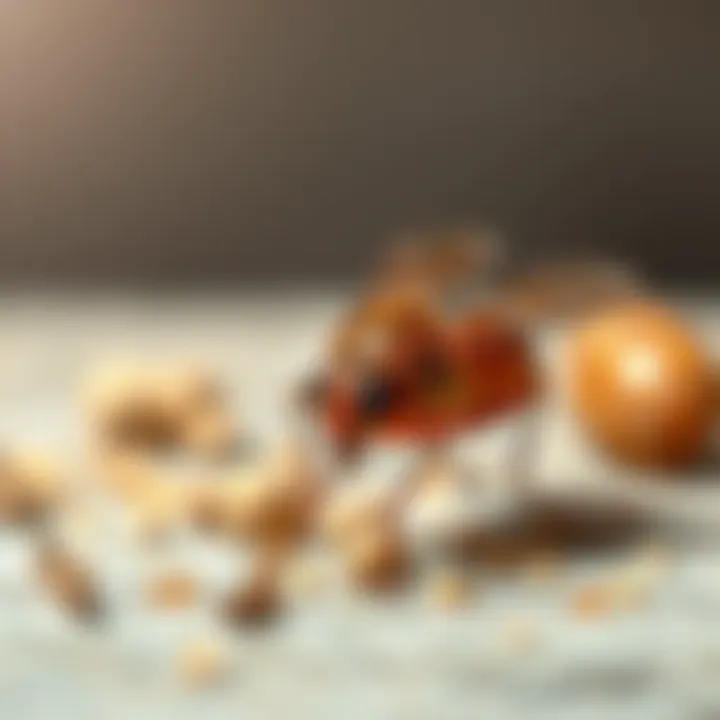Home Remedies for Flea Control: A Complete Guide


Intro
Every homeowner knows that maintaining a comfortable, healthy living space is a top priority. Nothing quite ruins that peace of mind like an unexpected flea invasion. These tiny pests not only bite, leaving itchy welts on both humans and pets, but they can also multiply at an alarming rate. This guide will steer you through effective home remedy flea repellents, focusing on safe and accessible methods anyone can try.
In today's world, where chemical treatments often take center stage, exploring natural solutions can be the best course of action. Not only are home remedies often cheaper and accessible, but they are also kinder to the environment. Here, we’ll dive into the science behind these traditional methods, provide practical application steps, and arm you with the knowledge needed to manage flea infestations effectively.
Prolusion to Flea Infestations
Fleas are more than just a nuisance; they can turn a happy home into a battleground. Recognizing the signs of flea infestations early can spell the difference between a minor annoyance and a full-blown invasion. In this section, we will explore the significance of understanding fleas and why a proactive approach can aid in pest management.
Flea infestations tend to sneak up on homeowners, often appearing in warm seasons when these little pests become most active. Knowing the lifecycle of fleas can help in effectively controlling them. Fleas may hitch a ride on pets, clothing, or even furniture, making it crucial to identify their presence as soon as possible.
- Key Points to Consider:
- Fleas reproduce rapidly—an adult female can lay hundreds of eggs in just a few days.
- Their lifecycle includes eggs, larvae, pupae, and adults, each stage presenting unique challenges for control.
- Understanding how fleas operate aids in developing an effective pest management strategy.
Being armed with information about these pests enhances the capacity of house owners to fight against infestations effectively and sustainably.
"Prevention is better than cure, especially when dealing with pests that multiply like rabbits."
This guide serves as a comprehensive resource for every household looking to implement home remedies for flea control. Armed with knowledge, readers can take back their homes from these persistent parasites. Let's now dive deeper into these little creatures to fully grasp their ways.
Understanding Fleas: A Brief Overview
Fleas are small, nimble insects that belong to the order Siphonaptera. They depend on the blood of their hosts for sustenance, primarily targeting mammals and birds. Their flattened bodies allow for easy movement through fur and feathers. Once they feast on blood, they begin to reproduce while leaving behind itchy bites that can cause considerable discomfort not just for pets, but also for humans.
Despite their minuscule size, fleas can cause serious health issues. They may transmit diseases and trigger allergic reactions, leading to secondary infections from incessant scratching. Understanding the biology and behavior of fleas can help homeowners create effective strategies for both prevention and extermination.
Why Choose Home Remedies?
Many homeowners might be skeptical about the efficacy of home remedies for flea control. Yet, there’s a growing interest in shifting away from chemical solutions for various reasons.
- Safety: Home remedies often pose fewer risks compared to conventional pesticides that can harm pets, children, or the environment.
- Accessibility: Most ingredients for DIY flea solutions are readily available, making solutions easy to whip up in your kitchen or pantry.
- Cost-Effective: Instead of shelling out thick wads of cash on commercial flea treatments, simple ingredients like vinegar, salt, or essential oils can do the trick.
Promoting a more natural approach aligns well with many modern households' goals—balancing effectiveness with eco-friendly practices. Understanding these motivations helps reinforce why looking into home remedies isn’t just a fleeting trend.
With this understanding in place, we can now turn to practical solutions that allow you to reclaim your space from these unwanted invaders.
Common Home Remedies for Flea Control
Fleas can be quite a nuisance in any household, and while traditional chemical options exist, many prefer to seek out home remedies. The appeal of these natural solutions lies not only in their accessibility but also in the desire to avoid harsh chemicals that may pose risks to pets and children. In this section, we'll delve into various effective home remedies that have the potential to control flea populations effectively.
Essential Oils as Natural Repellents
Essential oils have gained popularity in recent years for their natural pest-repelling properties. Their concentrated formulas, derived from various plants, make them potent contenders against fleas. By understanding which essential oils can be particularly effective, homeowners can choose the right ones based on their preferences and availability.


Peppermint Oil
Peppermint oil isn’t just another fragrant essential oil; it's a pest repellent powerhouse. One of its key characteristics lies in its strong scent, which can significantly deter fleas from invading your space. This oil is not only effective but has the added bonus of making your home smell fresh and inviting. One unique feature of peppermint oil is its ability to soothe irritations; hence it can also be beneficial if your pets have been scratched up by these pesky companions.
However, caution is essential as concentrated peppermint oil can irritate the skin if applied topically. Always dilute it properly before use. A simple peppermint-infused spray can work wonders when misted on carpets and pet bedding.
Lavender Oil
Lavender oil is renowned for its calming properties, but it also has impressive bug-repelling capabilities. Its pleasant floral scent can mask the odors that attract fleas while simultaneously putting you and your pets at ease. This oil is popular because it's generally safe for pets when used properly. You can create a lavender spray by mixing it with water and a bit of alcohol, making it a versatile solution for both calming and flea-repelling purposes.
Yet, since lavender also attracts certain beneficial insects, it’s essential to strike a balance and combine its use with other repellents for maximum effectiveness.
Rosemary Oil
Rosemary oil adds an aromatic flair while fighting off fleas. With natural insect-repelling properties, it’s a beneficial choice for flea management. Known for its robust scent, it serves as a deterrent to fleas while releasing pleasant herbal notes into your home. Its unique advantage is its ability to blend well with other oils, providing a more potent mixture.
However, rosemary oil application should be considered carefully as sometimes pets might have varying reactions. As part of an all-natural flea control system, it's often most effective when combined with other essential oils.
Vinegar Solutions: Techniques and Tips
Vinegar is a culinary staple, but its applications extend beyond the kitchen. It's an effective solution for flea control as well, known for its ability to alter the pH balance of your dog's skin, making it less hospitable for fleas. There are two main types of vinegar that can be utilized.
Apple Cider Vinegar
Apple cider vinegar, often touted for its myriad health benefits, can also serve as a potent flea remedy. This vinegar's key characteristic is its acidity and rich enzyme content, which disrupts fleas' survival. A common approach is to mix equal parts of apple cider vinegar and water and spray it on pet fur, avoiding the eyes. It not only repels fleas but can also soothe irritated skin, making it a great supplement to your regular grooming routine.
One unique feature is that apple cider vinegar can also help freshen your home. While generally safe for pets, some individuals might prefer a different vinegar due to varying tolerances, so always monitor your pet's reaction when first used.
White Vinegar
White vinegar is another effective solution that can be easily found at most homes. Its strongest point lies in its powerful acidity, which can help to eliminate flea eggs and larvae. A simple mixture of white vinegar and water can be used as a spray on breeding grounds such as carpets or pet bedding.
It’s also worth noting that white vinegar does not have the same residual scent as apple cider vinegar; hence it may be preferable for those sensitive to smells. However, while it’s unlikely to cause harm, due diligence in monitoring reactions in pets is always a wise approach.
Salt as a Drying Agent
Salt has peculiar properties that aid in flea control. When introduced to areas infested with fleas, salt acts as a drying agent. This natural remedy works by dehydrateing adult fleas, larvae, and eggs, effectively disrupting their lifecycle. Sprinkling salt over carpets and fabrics before vacuuming can help significantly reduce flea populations. While it might not show immediate results, the cumulative effect over a few days can be substantial.
Baking Soda: An Additional Barrier
Baking soda is another household product that can be leveraged in the fight against fleas. Its fine granules can penetrate deep into carpets and upholstery, and when used in conjunction with salt, it can provide an effective barrier that disrupts fleas. You can sprinkle a mixture of baking soda and salt on your carpets, let it sit for about 15 minutes, and then vacuum thoroughly. This process not only removes fleas but can also refresh your carpet, leaving it looking and smelling better.
In closing, understanding and utilizing common home remedies for flea control can make a notable difference in how efficiently you manage pest problems in your home. Though these methods may take time to see results when combined effectively, they present a sustainable way for households to combat flea infestations.
Homemade Flea Traps: Methods and Materials


Fleas can be a real nuisance, particularly for homeowners with pets. One of the best strategies for taking back your space from these unwelcome guests is through homemade flea traps. Not only are they cost-effective, but they utilize readily available materials around the home. Creating and implementing these traps can help reduce the flea population significantly.
The importance of homemade flea traps lies in their capacity to catch adult fleas before they have a chance to reproduce. Fleas reproduce at an alarming rate, so addressing the adult population through trapping is critical. Additionally, these traps are always safer for the environment, offering a green alternative to chemical solutions.
Homemade traps work on simple principles, primarily based on the attraction of fleas to light and warmth. By understanding the basic setup and advantages, homeowners can take an effective step toward a flea-free environment. Below are some additional elements to consider when creating these traps:
- Accessibility: Most of the ingredients and materials required to create these traps can be found around the house. This makes them easy to assemble without running to the store.
- Safety: Unlike chemical treatments that may pose risks to pets and children, homemade traps pose little to no danger, using basic household items.
- Sustainability: Using what you already have not only helps the wallet but also minimizes waste, promoting environmentally friendly practices.
Setup Process: A Step-by-Step Approach
Creating homemade flea traps seems daunting, but it can be straightforward with a step-by-step process:
- Gather Your Materials: You will need shallow bowls, warm water, dish soap, and a light source (like a lamp or candle).
- Create Your Solution: Fill each bowl with a mixture of warm water and a few drops of dish soap. The soap breaks the surface tension of the water, ensuring fleas can't escape once they land in it.
- Position the Traps: Place the traps in areas where you've noticed flea activity—this could be near pet beds, carpets, or along baseboards.
- Keep the Light On: Place a light source a few inches above the traps. This attracts fleas, luring them into the bowl. Given that fleas are naturally attracted to heat and light, this strategy enhances their efficacy.
- Monitor and Refresh: Check the traps frequently, especially on the first few days after set-up. Dispose of the contents regularly and refill with fresh soapy water as needed.
Effectiveness of Homemade Traps
The effectiveness of homemade flea traps can vary, yet understanding their mechanics reveals why they can be effective. These traps primarily target adult fleas, which helps in achieving a noticeable reduction in both flea sightings and the overall population.
- Continuous Catching: Traps can be left out indefinitely, catching any new fleas that may enter your home once you've started treating the problem. It's a proactive measure in your pest control arsenal.
- Ease of Use: The simplicity of setup and maintenance means homeowners can easily integrate this into daily routines without hassle.
- Cost-Effectiveness: Even if the catch rate isn’t massively high, they can dramatically lower the flea count without forking over cash for expensive chemical treatments.
Although homemade traps don't guarantee complete annihilation of fleas, they play a significant role in an integrated pest management strategy. For optimal results, they should be paired with other measures, including thorough cleaning and vacuuming. The collaboration of traps, ongoing pet grooming, and regular cleaning can greatly compound their overall impact. Remember, persistence is key, so keeping your traps active while exploring other methods will lead you closer to a flea-free home.
"An ounce of prevention is worth a pound of cure," and staying vigilant is paramount in keeping your space flea-free.
For further information and insights about flea control, consider checking resources like Wikipedia, or Reddit discussions on natural pest management.
Maintaining a Flea-Free Environment
Creating an atmosphere that is less conducive to flea activity is an essential part of effective pest management. Fleas thrive in warm, humid conditions, and a neglected environment provides them with the ideal breeding ground. Addressing this bug problem from a prevention angle can save you time, hassle, and unnecessary expense in the long run.
Regular attention to cleaning and maintenance can significantly reduce the likelihood of an infestation. By keeping your home tidy, you not only enhance its overall appearance but also make it less appealing to these pesky pests. Below are key practices:
Regular Cleaning and Vacuuming
Consistent cleaning habits are fundamental in your battle with fleas. Vacuuming floors, carpets, and furniture regularly is vital. Flea eggs and larvae can hide in the tiniest crevices, and your vacuum cleaner can help you reach them. Here are some pointers:
- High-Traffic Areas: Focus on areas where your pets spend most of their time. Fleas love to linger where they find warmth and fur.
- Use Strong Suction: Make sure your vacuum has a powerful suction to pick up any hidden fleas, eggs, and larvae. Consider using attachments to clean corners effectively.
- Dispose Immediately: Don’t forget to empty your vacuum bag or container straight into a sealed plastic bag and discard it outside your home. This stops fleas from reentering.
“Keeping a clean house is not just an aesthetic choice; it’s a crucial part of pest prevention.”
In addition to vacuuming, washing your pet’s bedding and your own linens regularly with hot water helps eradicate fleas and their eggs. It’s a simple step with a big payoff.
Grooming Pets to Prevent Infestations
One of the most proactive steps you can take to prevent fleas is proper grooming of your pets. Regularly brushing your pets not only keeps their coats shiny but also provides an opportunity to check for fleas before they can hatch and spread. Here’s how to groom effectively:


- Use the Right Tools: Invest in fine-toothed flea combs and high-quality brushes designed for your pet's coat type. These tools help catch fleas before they become a problem.
- Establish a Routine: Set a regular grooming schedule. Make it part of your bonding time with your pet, or encourage a family member to lend a hand.
- Watch for Signs: While grooming, keep an eye out for any signs of fleas—these might include scratching or small black specks (flea dirt) in your pet's fur.
By incorporating thorough cleaning and grooming into your routine, you will create a hostile environment for fleas. Not only does this help keep your home flea-free, but it also improves the overall comfort and health of your pets and family.
Maintaining a flea-free environment is indeed a commitment, but with consistency and care, the rewards are profound. The peace of mind that comes from knowing your home is protected from these pests cannot be overstated.
Evaluating the Efficacy of Home Remedies
In the quest for effective flea control, assessing the effectiveness of home remedies is crucial. Homeowners are often tempted by natural solutions due to concerns regarding chemical insecticides and their potential side effects. Evaluating how well these remedies work is not just about effectiveness but also about safety, accessibility, and sustainability. By understanding the efficacy of these natural solutions, individuals can make informed decisions that best suit their living environments and families.
Home remedies serve as practical alternatives that align with eco-conscious values. As such, determining what works and what doesn’t can save time, effort, and resources. Utilizing common household ingredients can also be economically advantageous, reducing the need for expensive commercial products.
Evaluating home remedies is not only about results; it’s about finding a solution compatible with your lifestyle.
Factors Influencing Effectiveness
Several factors play into how effective home remedies can be against fleas. Here are some prominent ones:
- Concentration of Ingredients: Some methods work better with higher concentrations. For instance, essential oils, when diluted too much in carrier oils or water, may lose their repellent properties.
- Application Method: How a remedy is applied can greatly affect its efficiency. For example, simply spritzing a vinegar solution on surfaces might not reach hidden flea eggs or larvae lurking in carpets.
- Environmental Conditions: Temperature and humidity can influence flea behavior and the efficacy of natural repellents. A humid environment can bring fleas out of hiding, making sprays less effective without consistent reapplication.
- Duration of Exposure: Fleas do not die instantly from natural repellents. Continuous exposure is often required, meaning multiple treatments may be necessary to see results.
- Specific Species: Understanding the flea species infesting your home can guide the choice of remedy. For example, certain essential oils may target specific species more effectively than others.
By considering these elements, homeowners can refine their flea control strategies and better assess the impact of their chosen remedies.
Comparison with Chemical Solutions
When comparing home remedies with chemical solutions, it’s essential to weigh the pros and cons of each approach. While chemical solutions can provide a rapid response, they come with a myriad of concerns, such as toxicity to pets and humans, environmental impact, and the potential for systemic resistance in pests.
- Speed vs. Safety: Chemical solutions often promise quick results. However, the safety of these products can be questionable, particularly in households with children and pets. In contrast, natural remedies take longer to show effects but typically are safer to use around loved ones.
- Cost Consideration: Chemical treatments can put a dent in your wallet, especially if multiple applications are required. Home remedies, on the other hand, frequently use items already available in the kitchen or garden, translating to lower costs and minimal waste.
- Long-term Effectiveness: Home remedies may require more time and repeated applications, which can be a drawback. Yet, they often encourage sustainable practices that benefit the environment and reduce chemical reliance in the long run.
- Resistance: Fleas can develop resistance to chemical treatments, leading to a cycle of diminishing returns where stronger and often more harmful chemicals may be needed. Home remedies usually do not present this risk, as they often involve a blend of natural ingredients that pests do not adapt to.
The key takeaway here is to evaluate both options thoroughly. Understanding how home remedies measure up against chemical solutions can help inform your flea management strategy and promote a healthier living space.
Culmination: Sustainable Pest Management
In the battle against fleas, implementing sustainable pest management is not just beneficial; it’s essential. Home remedies showcased throughout this article provide homeowners with effective and safer alternatives to chemical treatments. By opting for natural solutions, individuals can mitigate health risks for both their families and pets, while also being kinder to the environment.
Recap of Home Remedies Discussed
To revisit the core strategies outlined:
- Essential Oils: Oils like peppermint, lavender, and rosemary not only repel fleas but also create a pleasant aroma in your home.
- Vinegar Solutions: Both apple cider and white vinegar serve as effective deterrents when applied to pets or sprinkled around infested areas.
- Salt: This simple kitchen staple acts as a drying agent, effectively dehydrating flea eggs and larvae.
- Baking Soda: An excellent addition to your flea management arsenal; it creates an abrasive environment that hinders flea survival.
- Homemade Traps: Utilizing common materials, these traps are a cost-effective way to capture adult fleas.
Each of these remedies contributes to a multi-faceted approach to pest management that is not only effective but sustainable.
Encouraging Sustainable Practices
As we wrap up, consider embracing and promoting sustainable practices in your household. Flea control isn’t a one-time fix; it requires vigilance and routine upkeep.
- Regular Cleaning: Continue frequent vacuuming and washing of pet bedding. This prevents reinfestation and maintains cleanliness in your home.
- Natural Grooming: Regularly groom your pets, using natural flea combs and treatments discussed earlier, to stay ahead of any infestations.
- Planting Flea-Repelling Herbs: Consider growing herbs like lavender or mint in your garden. Not only do they help repel fleas naturally, but they also beautify your space.
"Choosing sustainable methods stands at the forefront of responsible pest management. Every little step counts!"
By integrating these practices into your routine, you will create a healthier living environment. The balance of effectively handling flea issues while safeguarding your home and the planet is key.
For further information on sustainable pest management, one can refer to resources such as EPA or Centers for Disease Control and Prevention.



